Disclaimer: This post contains affiliate links to handpicked partners, including tours, gear and booking sites. If you click through or buy something via one of them, I may receive a small commission. This is at no extra cost to you and allows this site to keep running.
Outside the Old Town area, you’ll find its trendy New Town alter ego – a city much cooler than you think. Here’s what to do in Dresden, Germany.
Dresden is considered one of the most beautiful Baroque cities in Europe and while sightseeing in the Old Town is obligatory, it is also very limiting to understanding its true persona as a former city of post-war destruction and Soviet East Germany. When you visit Dresden, you’ll soon see two distinct sides of the city to explore.
Beyond the cultural heart of the city lies a more trendy and modern Dresden, where soviet GDR landscapes have been reinvented and where culture intersects with a vast green landscape.
If you look at a map of Dresden, you will see that the Augustus Bridge and the Elbe River cut the city into two distinct parts, surrounded by parkland. It’s natural to veer towards the Old Town first, and it should not be discounted. I stayed here since it is an accessible base to explore and central to all transport networks. It’s also here that your journey through the city’s history will naturally begin and be slightly distorted. Here’s why.
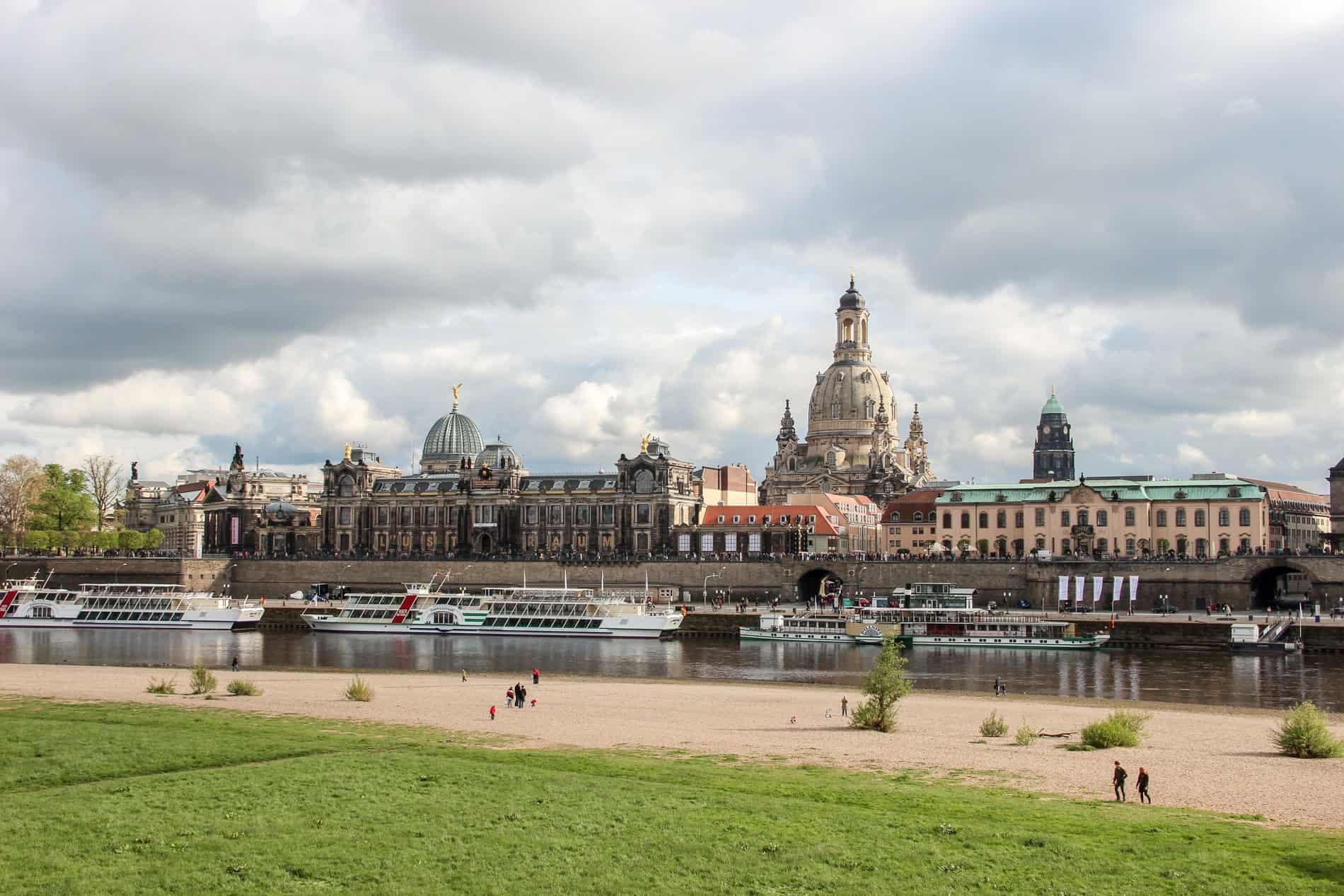
Here’s What to Do in Dresden, Germany – The Two Faces of the City
Contents
Dresden Aldstadt (Old Town) is New and Rebuilt
Our local guide asked us to point out the oldest building in the Old Town Square, and we all pointed at the Frauenkirche (the Church of Our Lady)—quite possibly the most dominant and beautiful of all the structures here. The nearby bland-looking office-style building was the oldest, and Frauenkirche, pictured below (and the area around it), had been rebuilt within the last 20 years with donations from all over the world as a monument for peace.
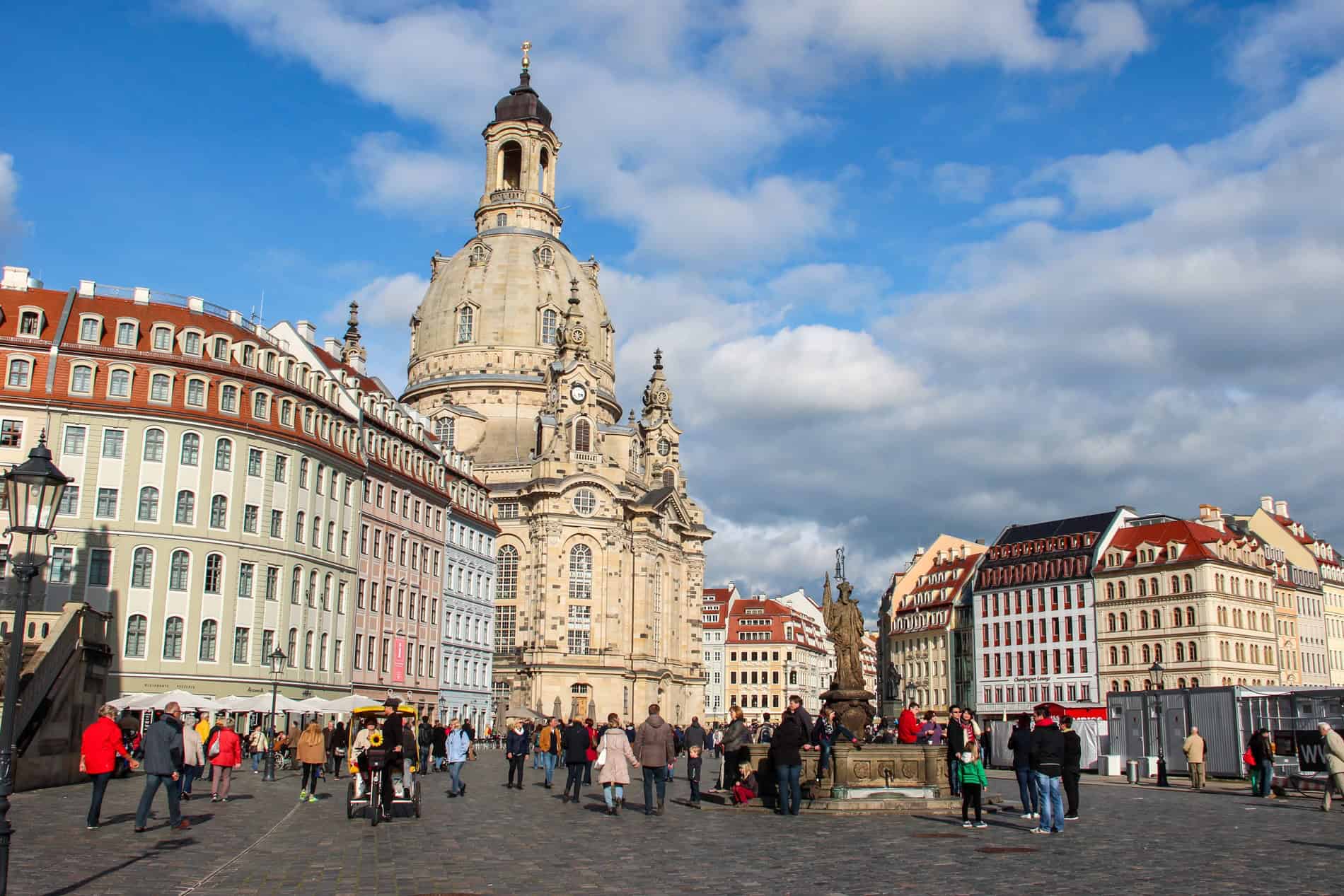
Frauenkirche, Dresden Altstadt (Old Town).
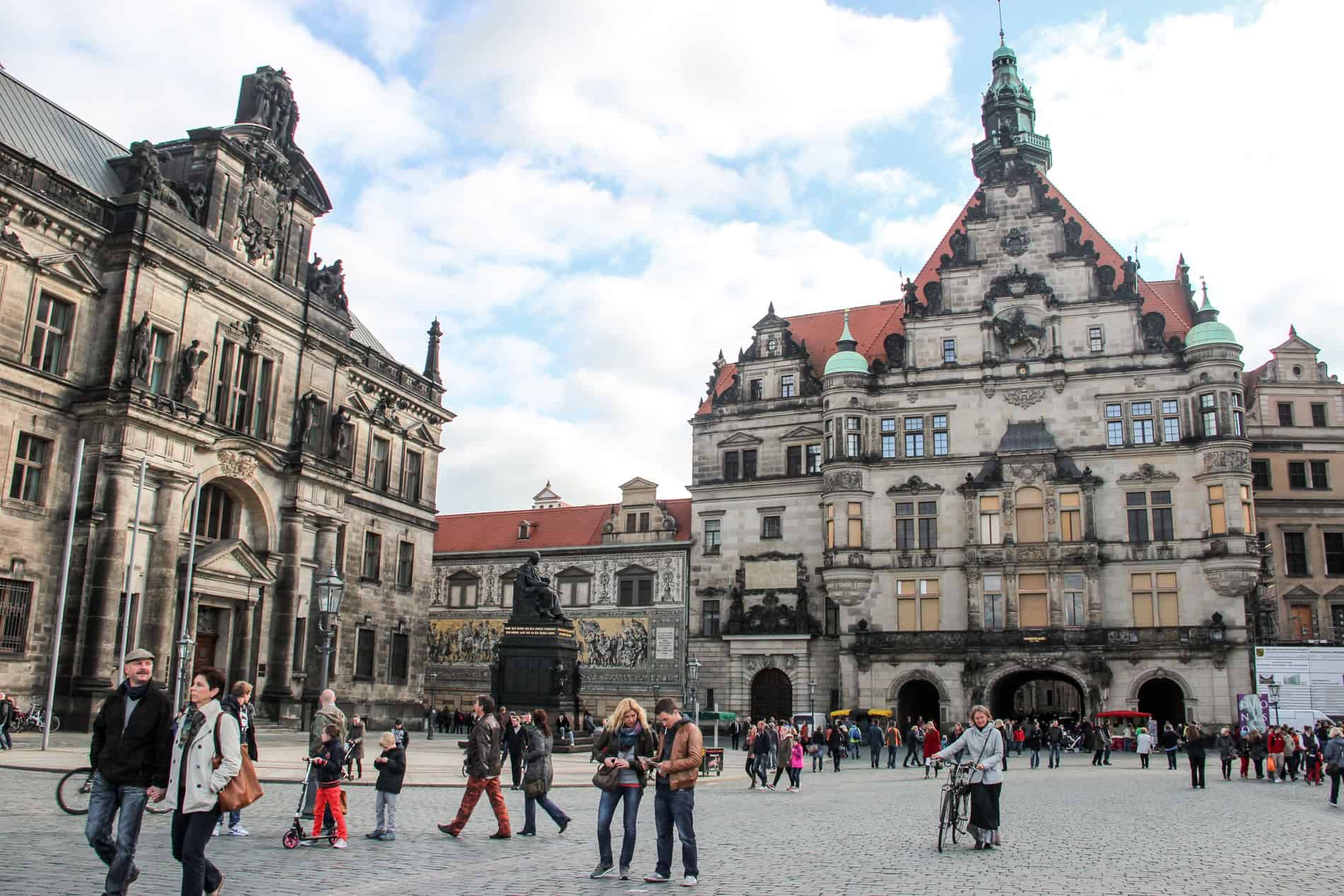
The Georgentor (George Gate) – Dresden’s first Renaissance building.
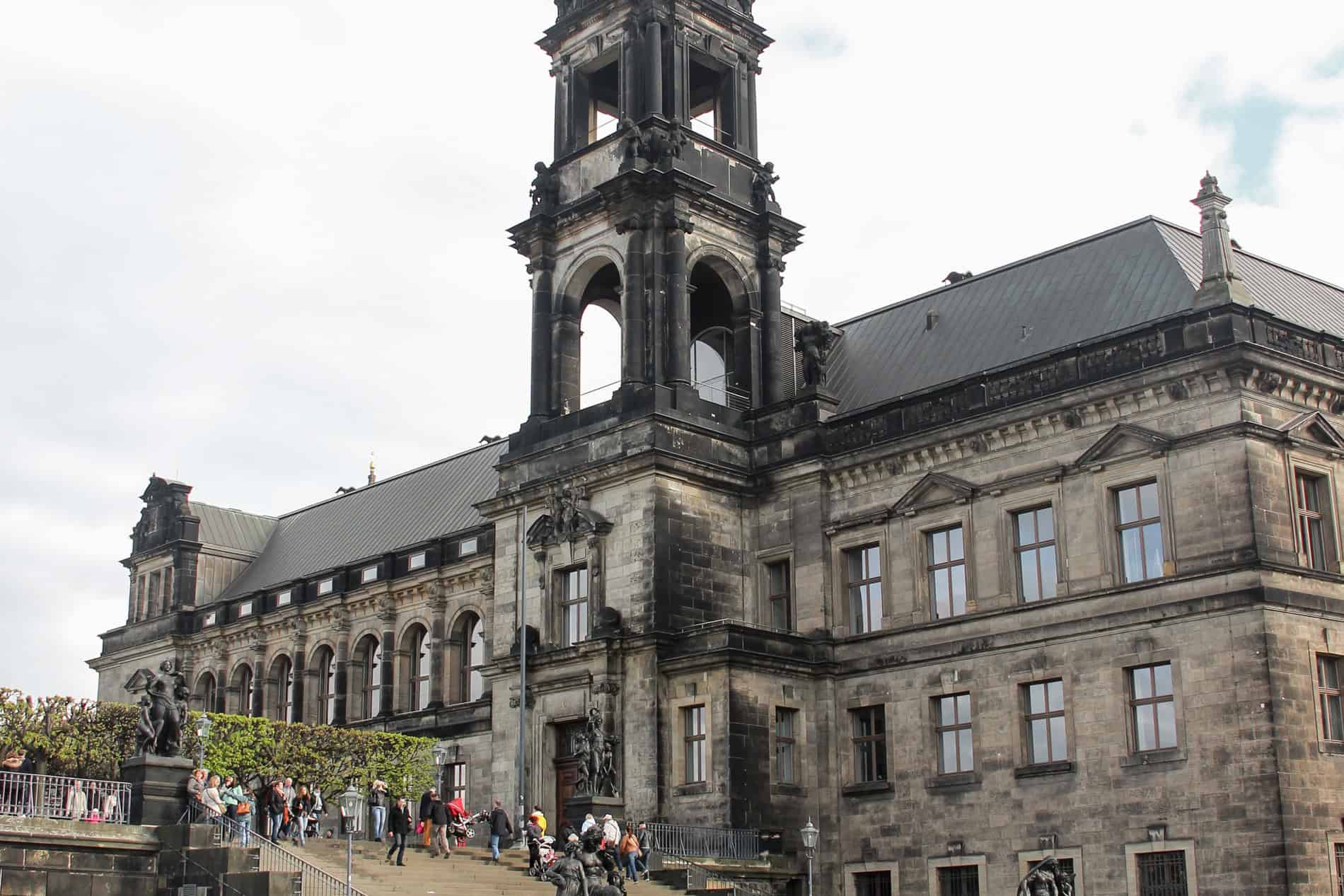
Dresden’s Courthouse, Oberlandesgericht.
Following extensive damage from allied bombing, which rendered 60% of Dresden to ruins, this area has been fully reconstructed. Before that, it was a space of rubble and desolation. While the Soviets kept some of the ruins as memorials of the war and built some ‘Stalin Baroque’ architecture on the east and west sides of the square, it wasn’t until the fall of the Berlin Wall that the city and its modern reconstruction sprang into life.
While some locals north of the river are quick to dismiss the Old Town as uncool and progressive, it is a preserved window into a history that could have otherwise been lost.
The ruins were rebuilt to look old again and return Dresden to its former glory. The love of art and high culture brought to the area by the Saxons and the later bourgeoisie remains. The city beats all year round, where Dresden’s Christmas Markets this side of the river remain some of the biggest in Germany.
You can visit the old master paintings and art collections of the Zwinger, admire the Royal Palace and Brül’s Terrace, enjoy the sounds of the Semperope (opera house), and wander amongst the other buildings famed with this distinct historical style. Just round your sightseeing day off in traditional feasting style by dining on sauerkraut, meat, and dumplings at the vaulted restaurant, Pulverturm.
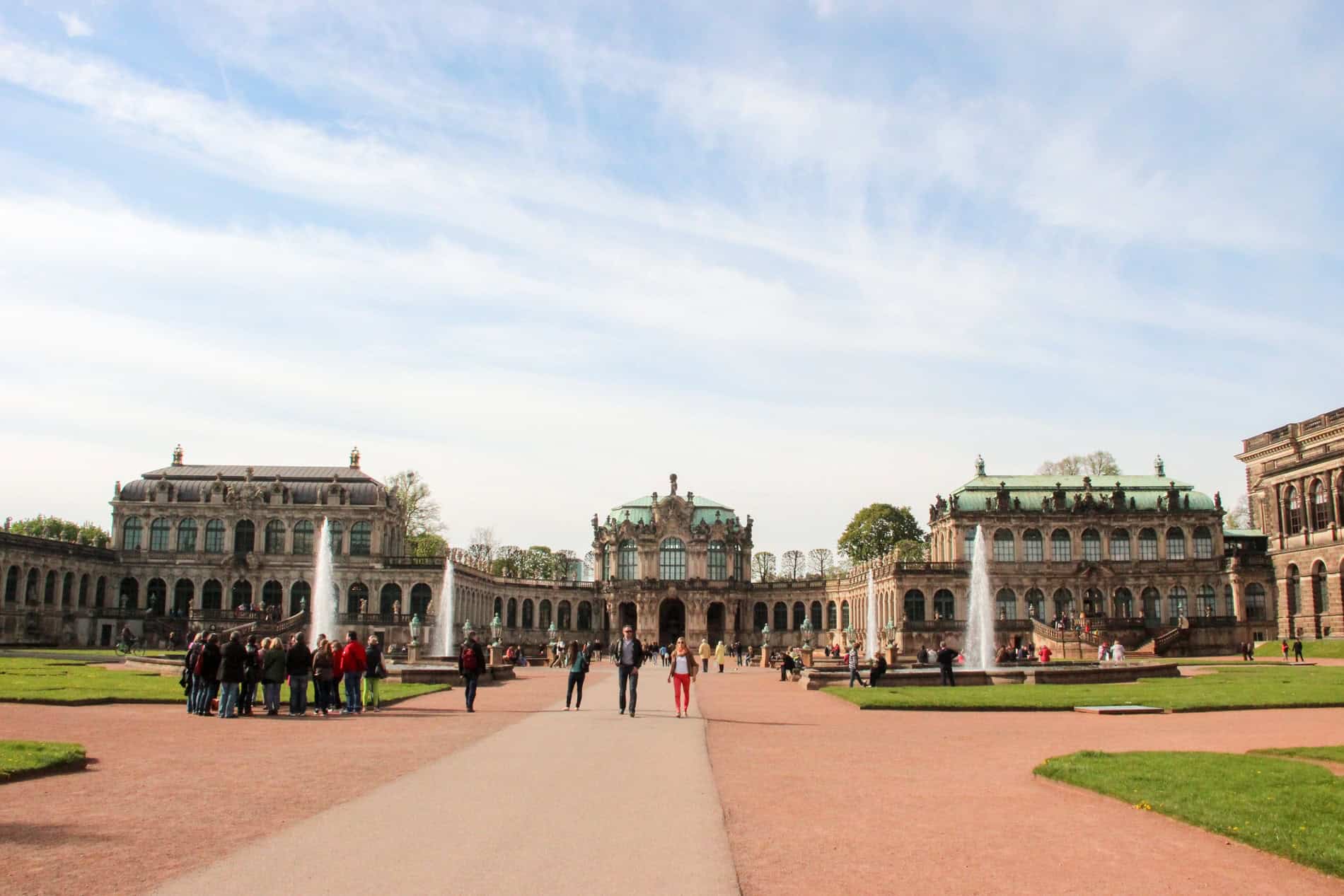
Zwinger Palace, Dresden.
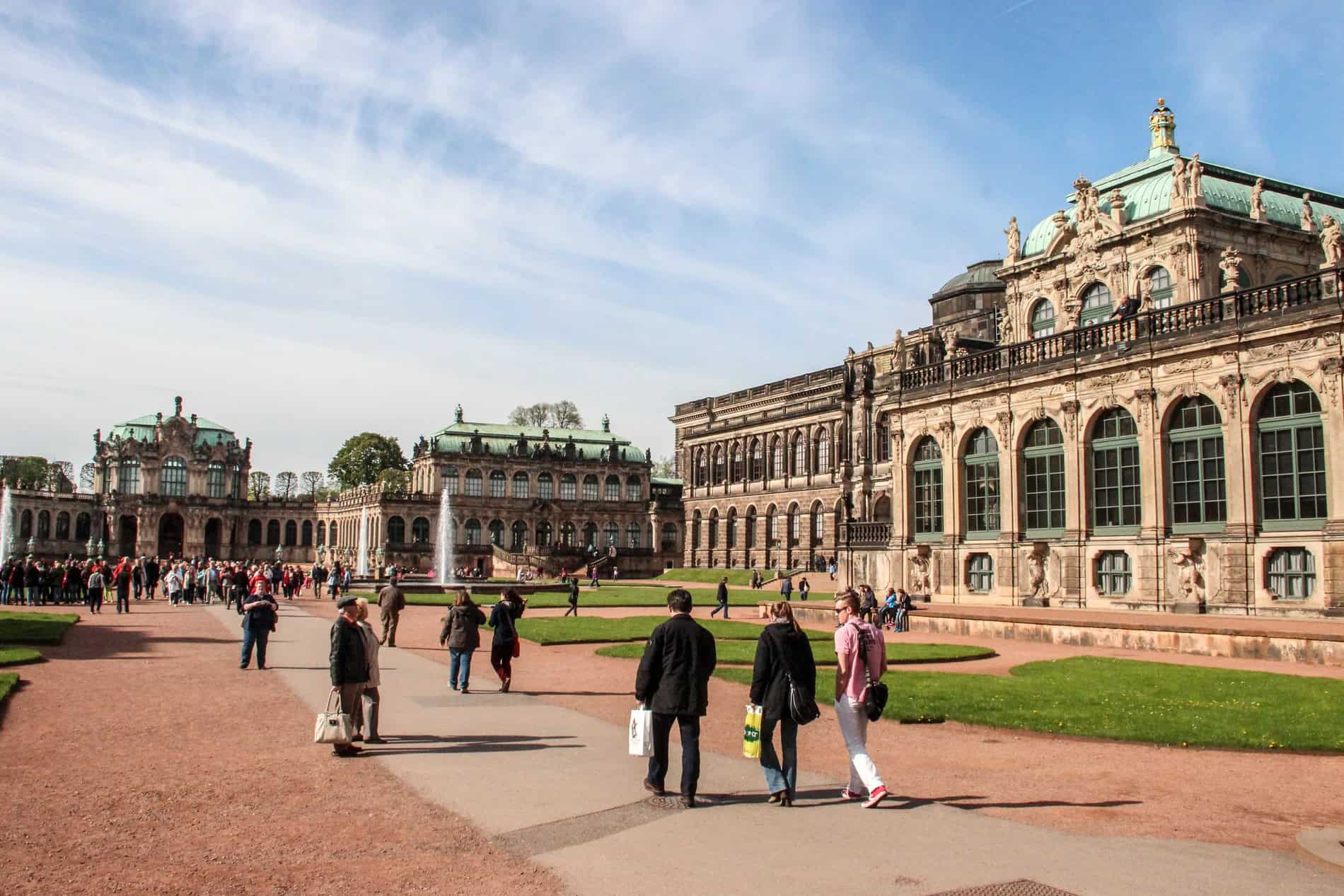
Zwinger Palace grounds.
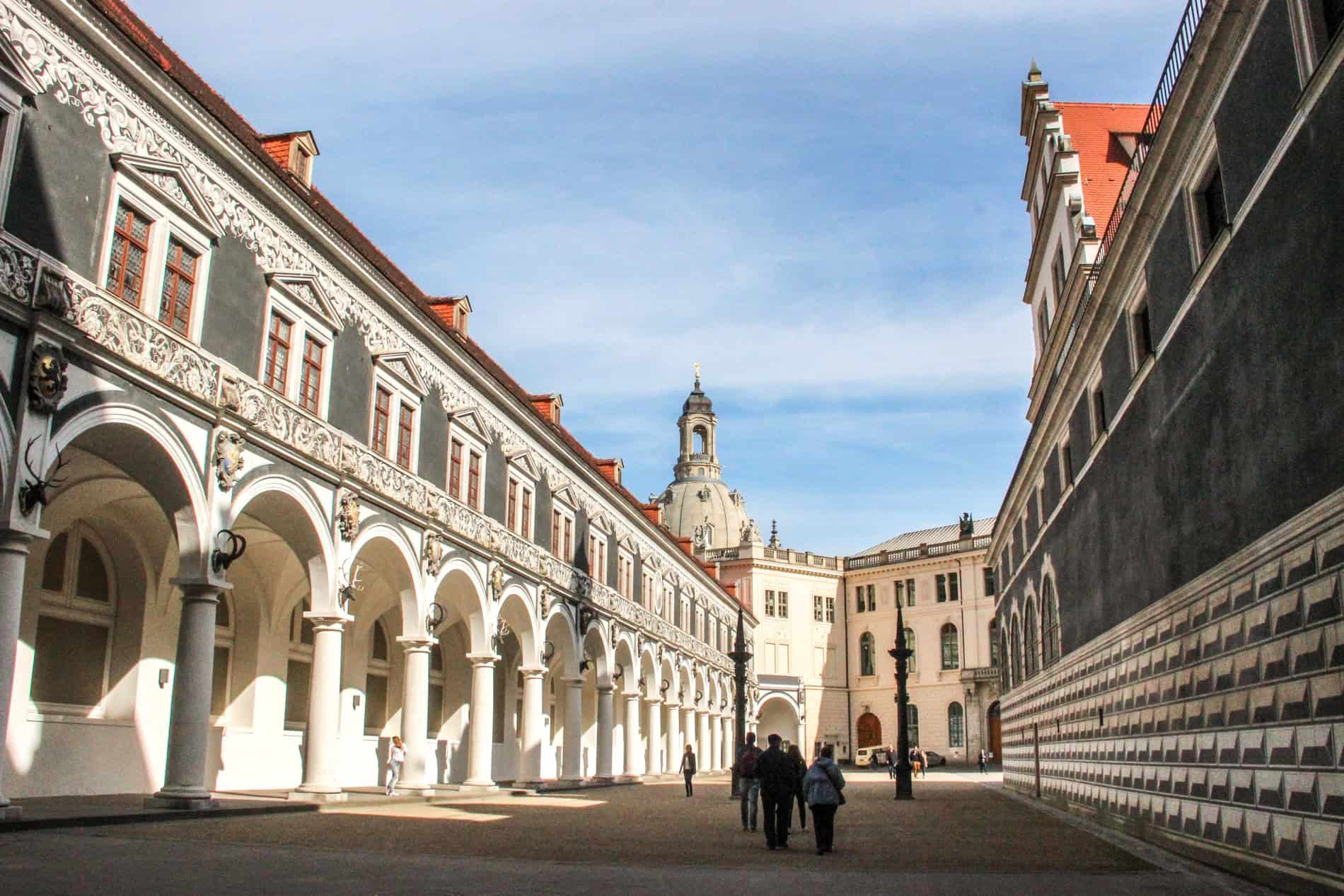
Stallhof courtyard, Dresden.
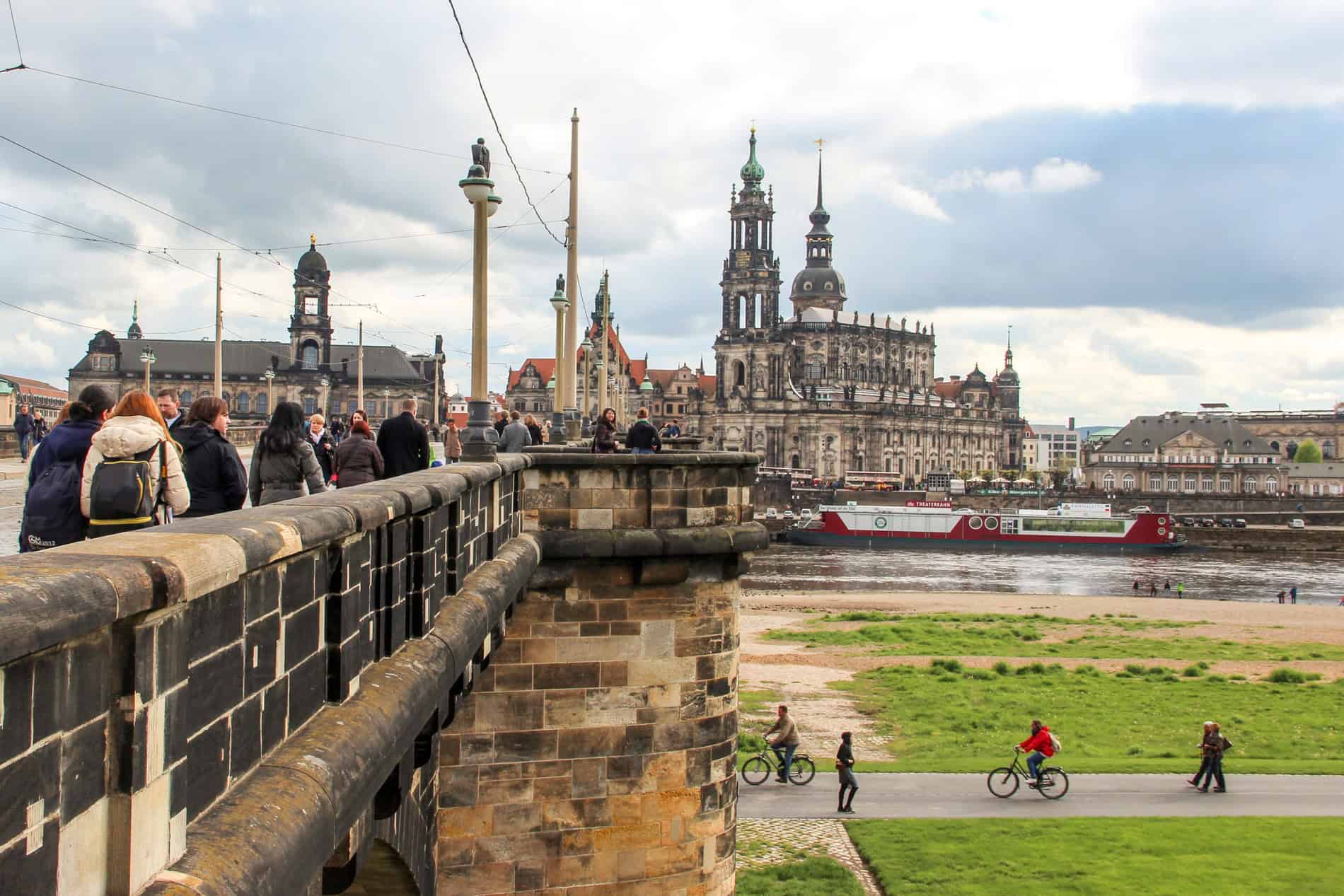
Crossing the Augustusbrücke (Augustus Bridge) to Dresden Old Town.
Dresden Neustadt (New Town) is the Oldest
The makeover of the Neustadt (New Town) –the once bland GDR urban industrial landscape – is in full swing north of the Elbe River. Cities throughout Germany have either demolished Soviet architectural structures or been creative in their reinvention, and Dresden is no exception.
In central Dresden, reunification signalled the chance for residents, landlords, and artists to make a statement. Dark and dingy houses and backyards were given an individual stamp, and high rises were given a coating of modernisation.
Walls were painted, covered in mosaics, or plastered with funky structures. Old run-down spaces were converted into vibrant cafes, bars, and clubs. Street art continues to be used as a social critique, marking a call against gentrification and those with money who will flood in and raise the rents.
Dresden, once known as ‘Tal der Ahnungslosen’ (the Valley of the Clueless) because it could not receive West German television signals and, therefore, only had access to the GDR’s propaganda-ridden TV, certainly speaks its mind now.
The quarter around Alaunstrasse and Louisenstrasse streets is the most interesting place to see this, and the most notable area to visit is the Kunsthofpassage (between Alaunstrasse and Görlitzer Strasse). It’s a labyrinth of small artistic courtyards, cafes, shops, and galleries in a myriad of colours and themes. It’s quite possibly one of the most interesting sites in Dresden and a representation of the ‘alternative’ side of the city.
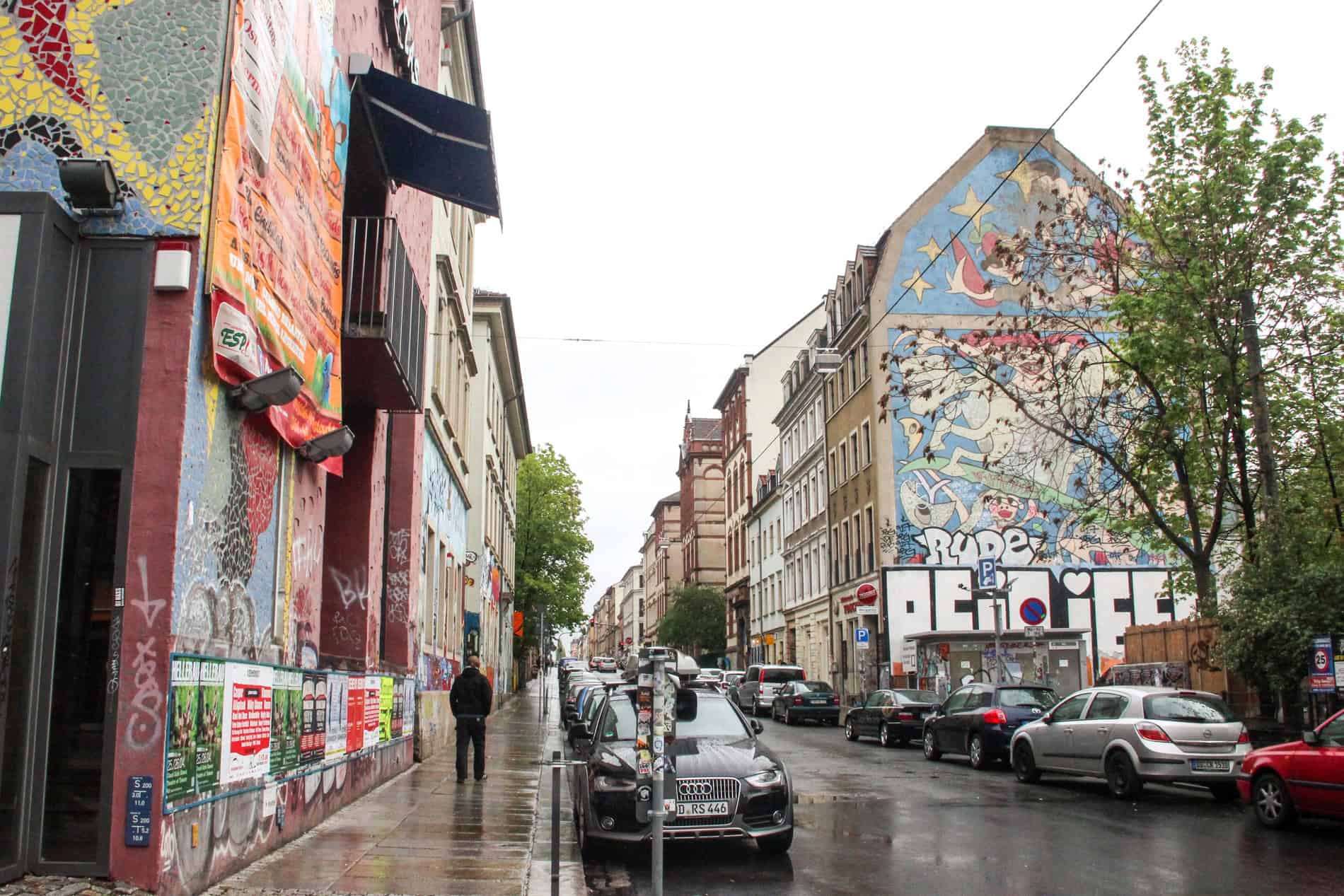
Street art of Dresden Neustadt.
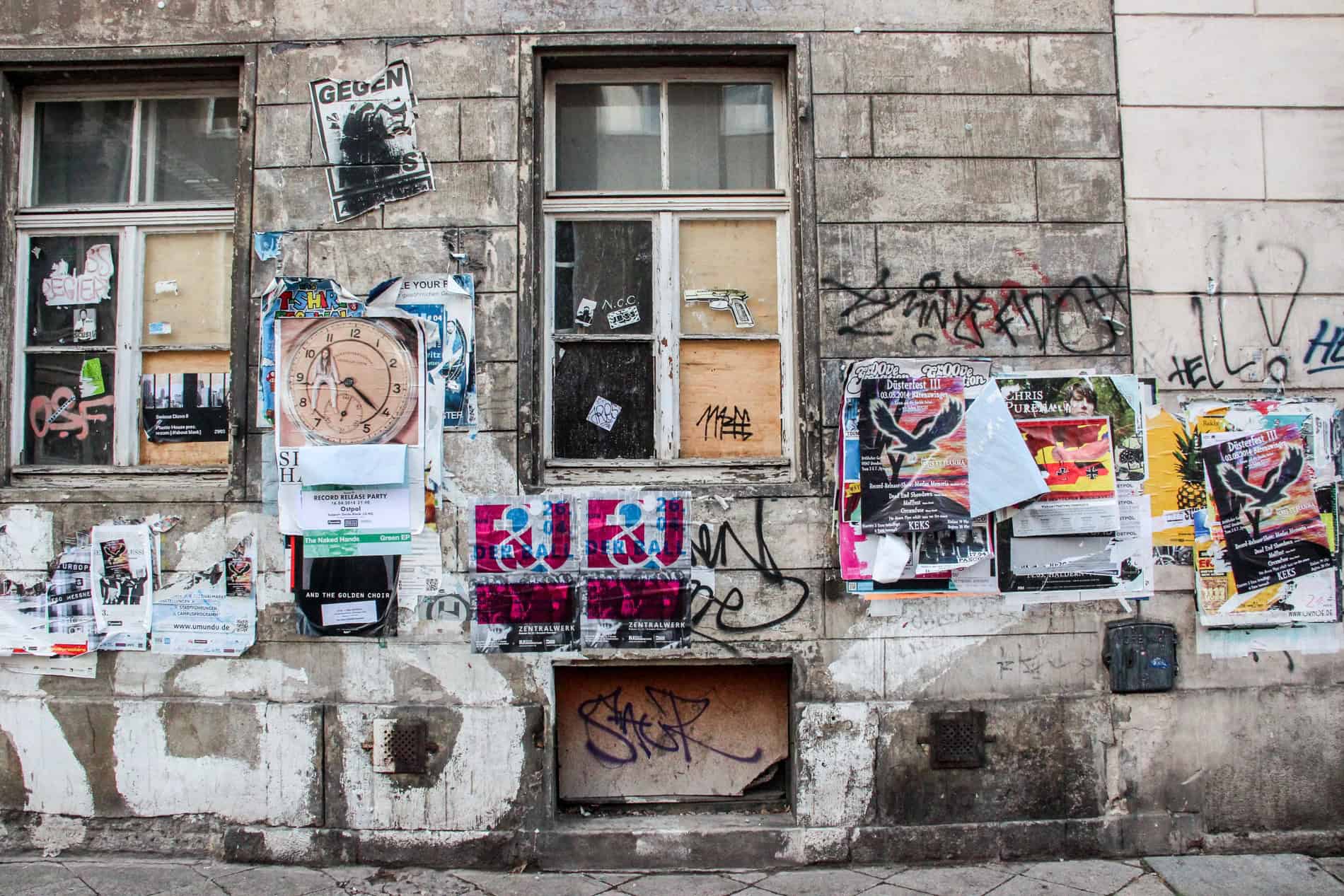
Art and statements in the revived New Town.
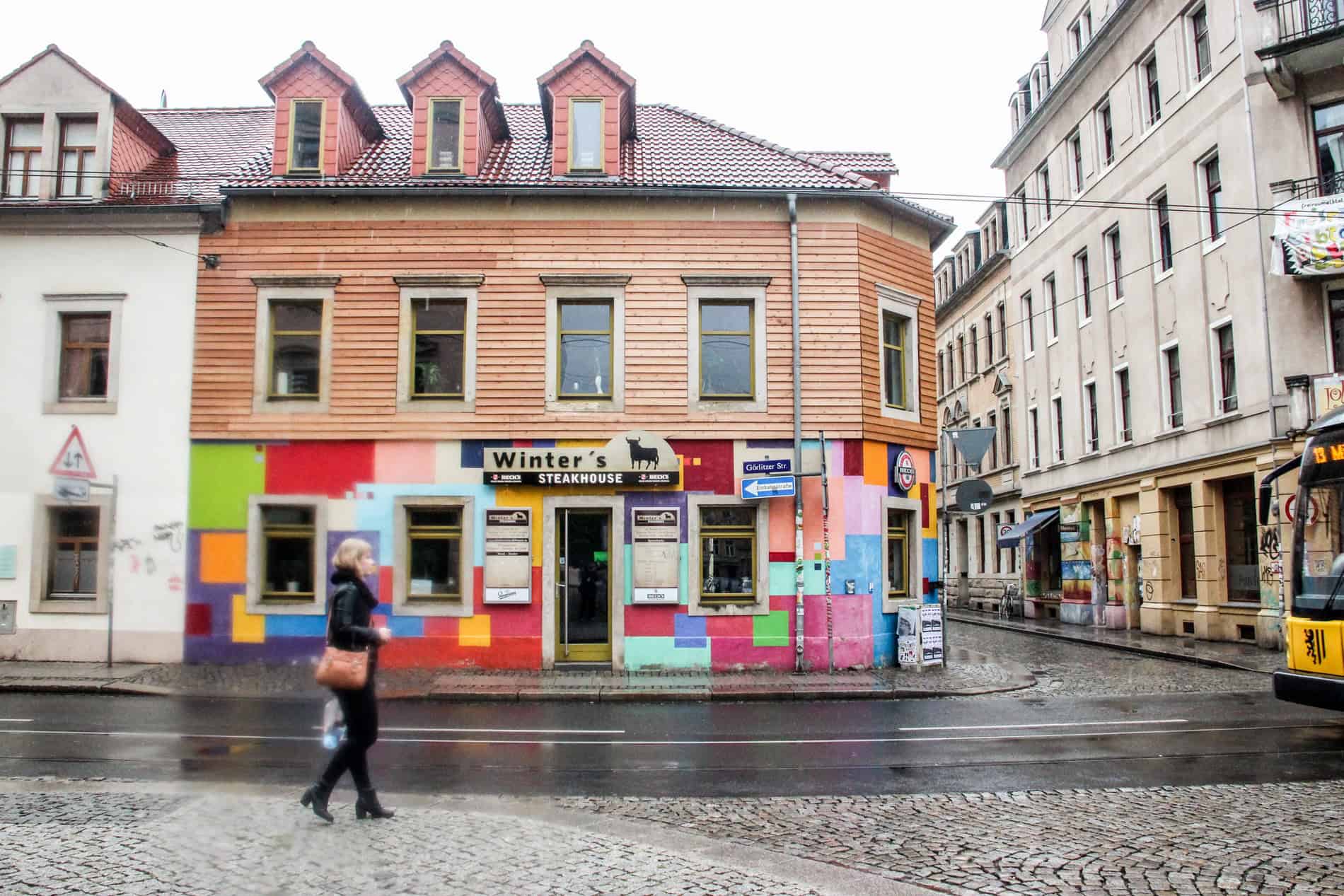
Colourful facades of Dresden Neustadt (New Town).
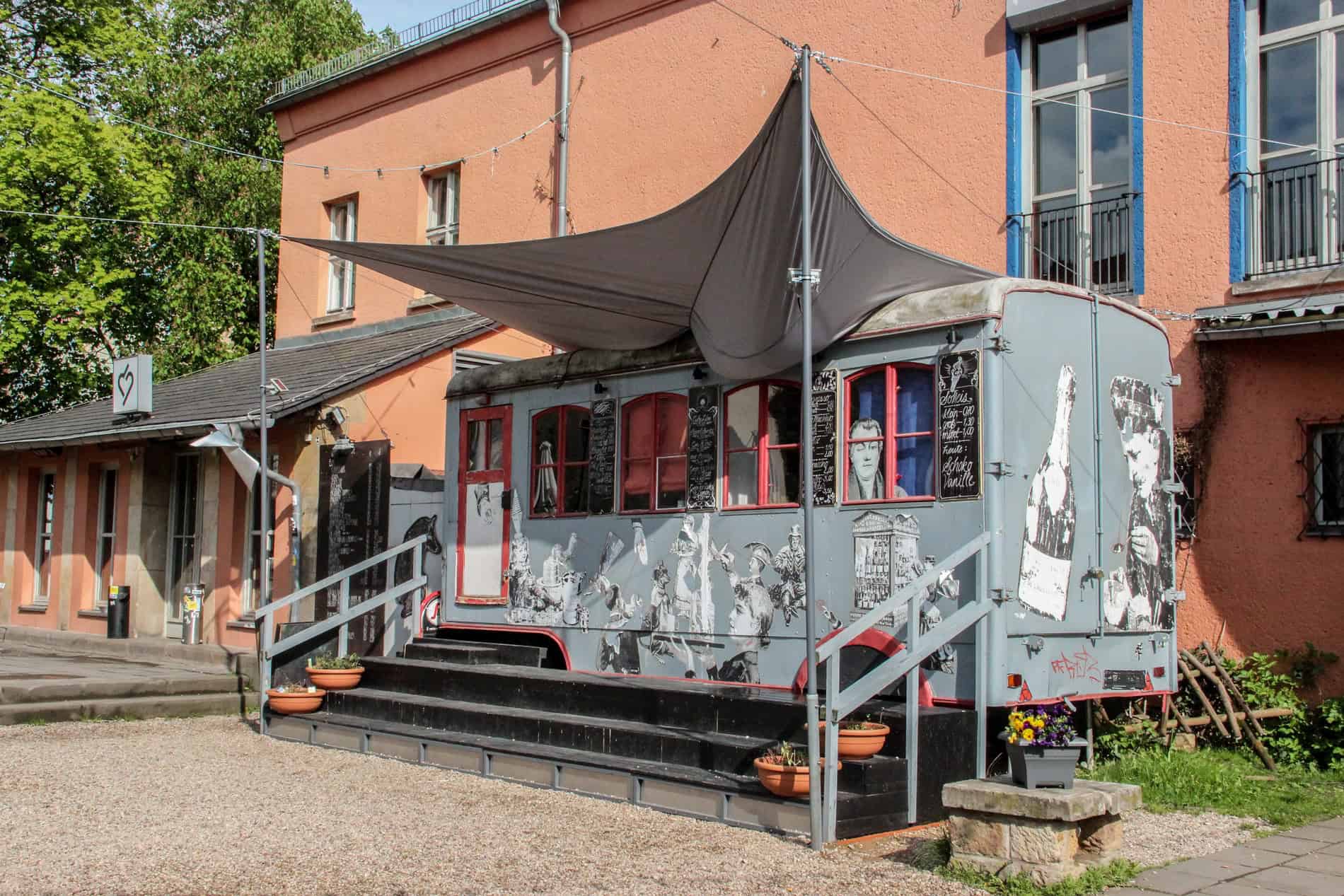
Scheune Bar in Dresden.
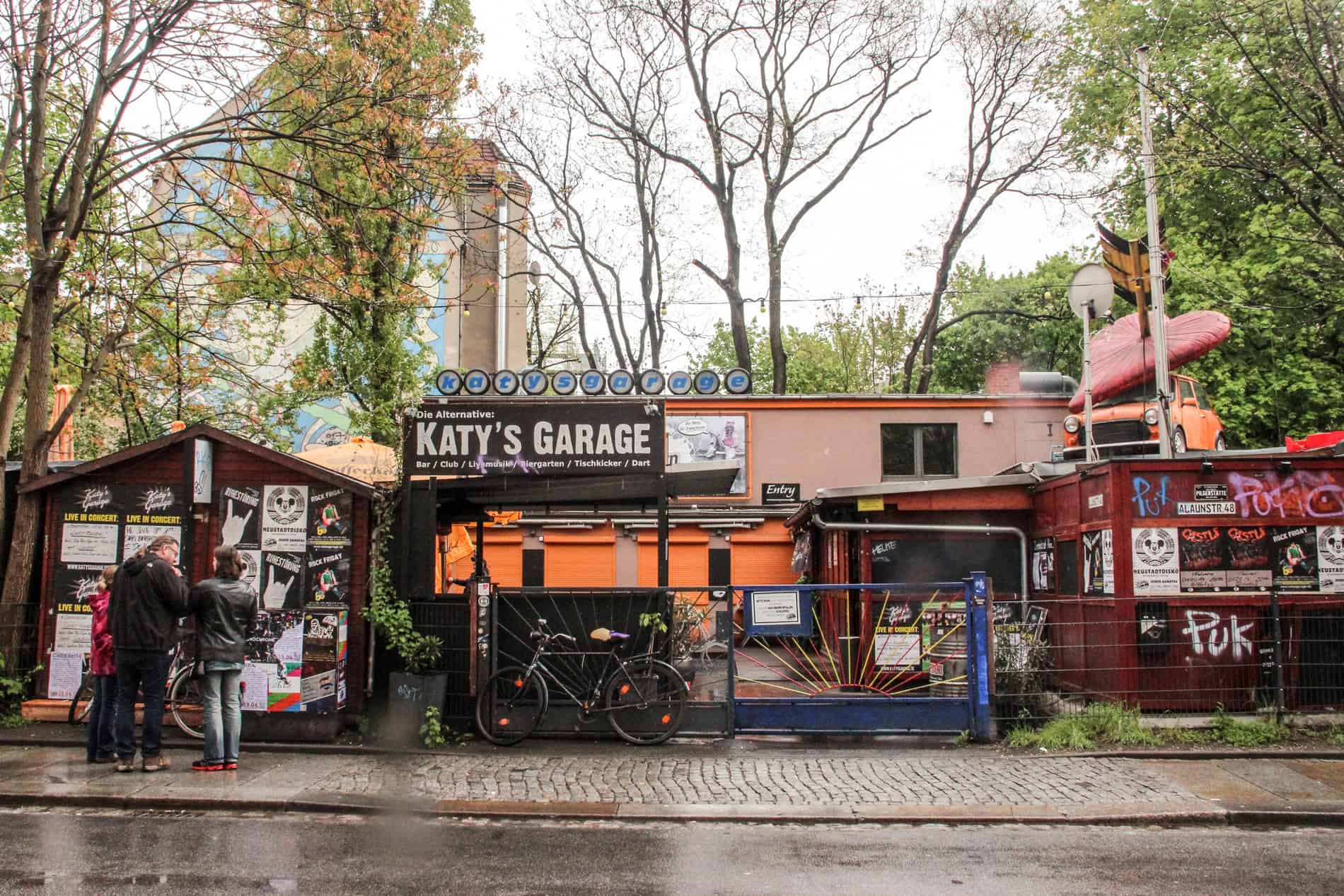
Katy’s Garage nightclub.
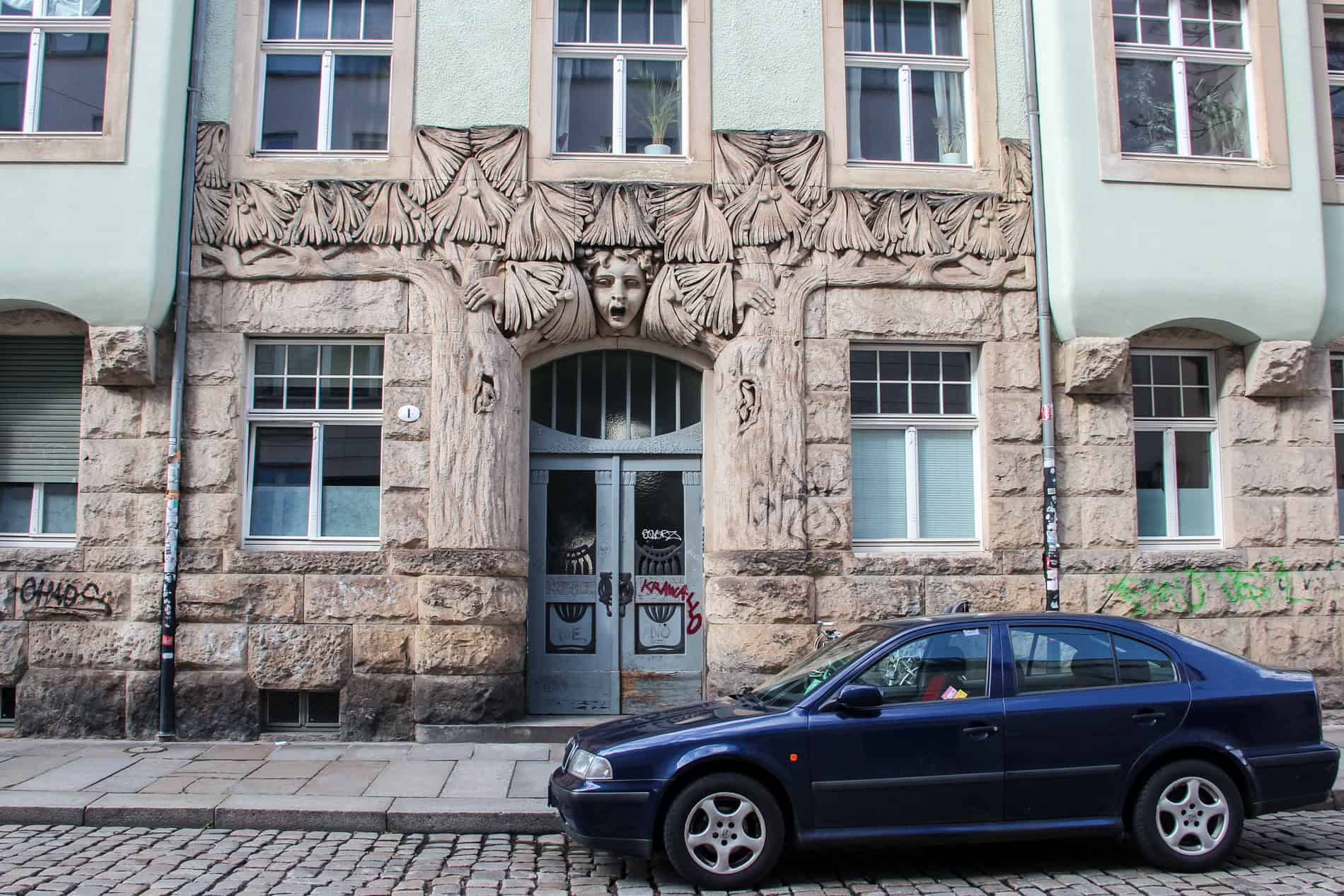
Jugenstil design can be found in Dresden Neustadt.
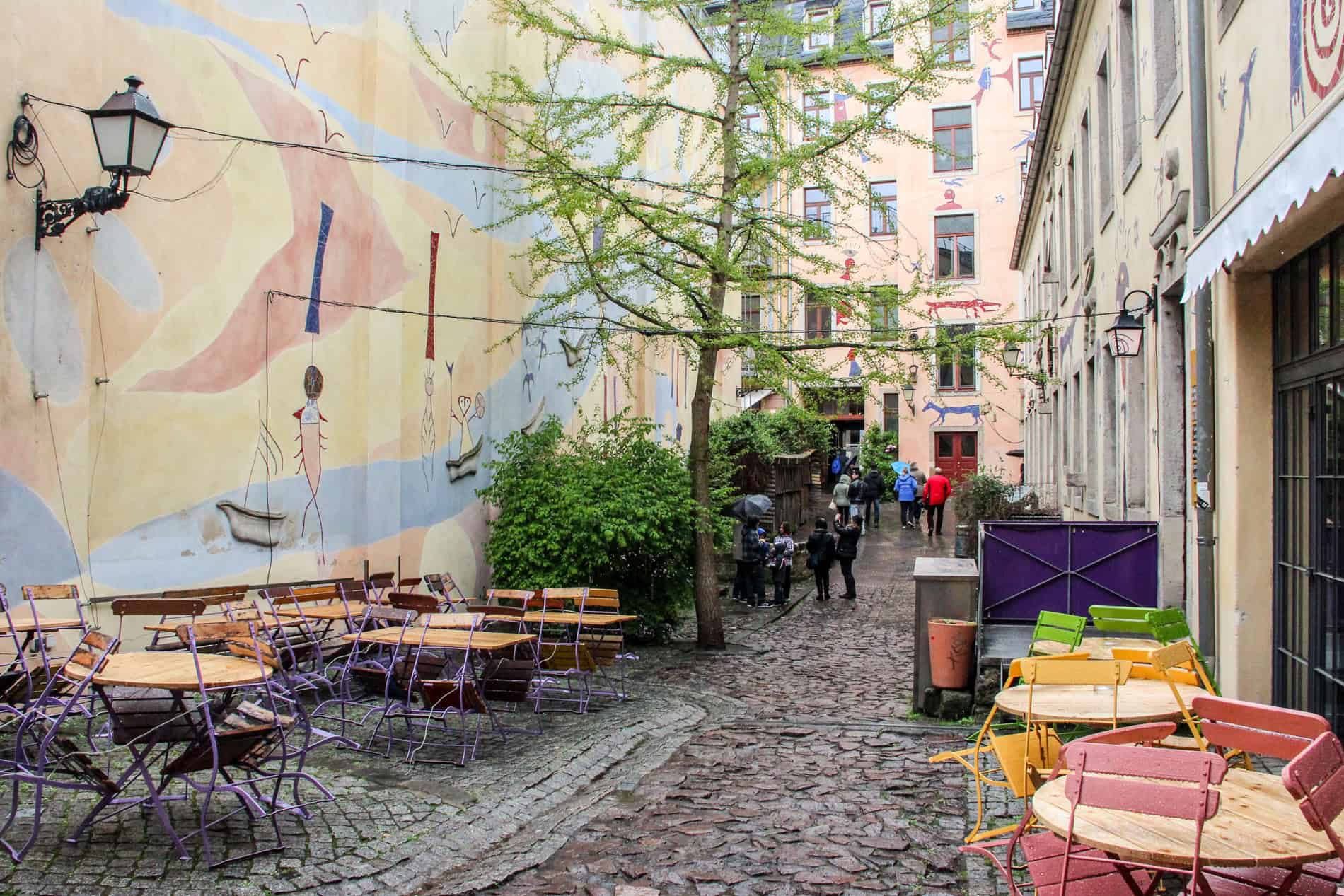
Dresden’s Kunsthofpassage area.
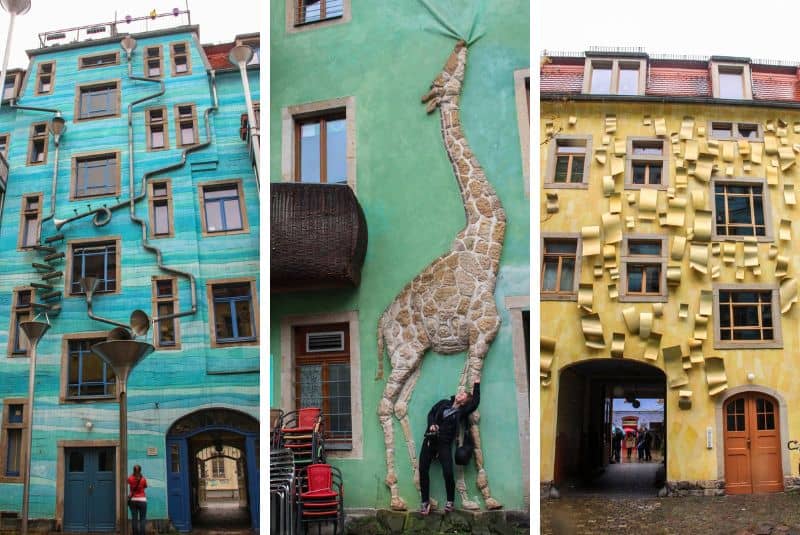
Funnel House, Giraffe House and the Yellow House in the Kunsthofpassage.
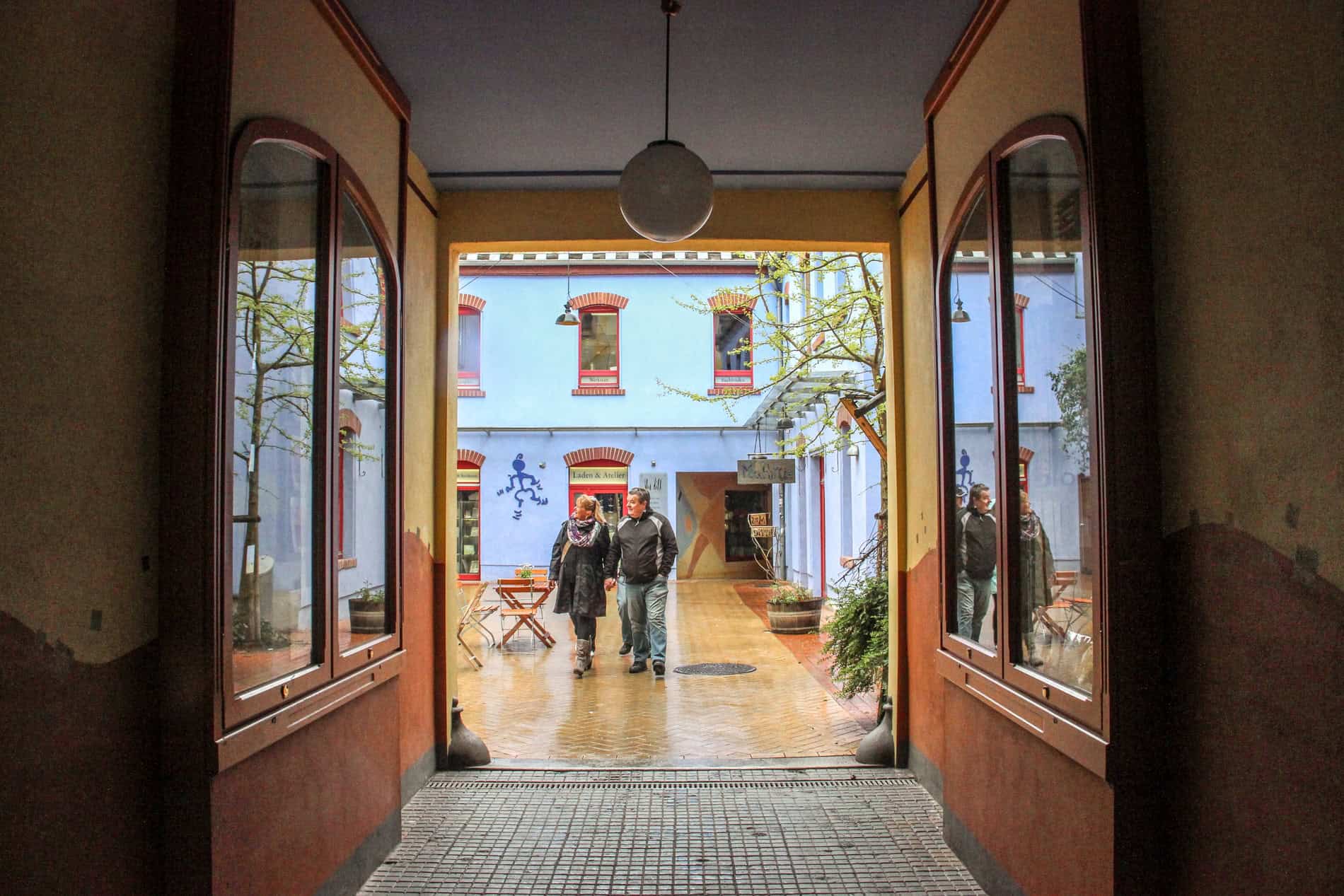
Dresden Kunsthofpassage courtyards.
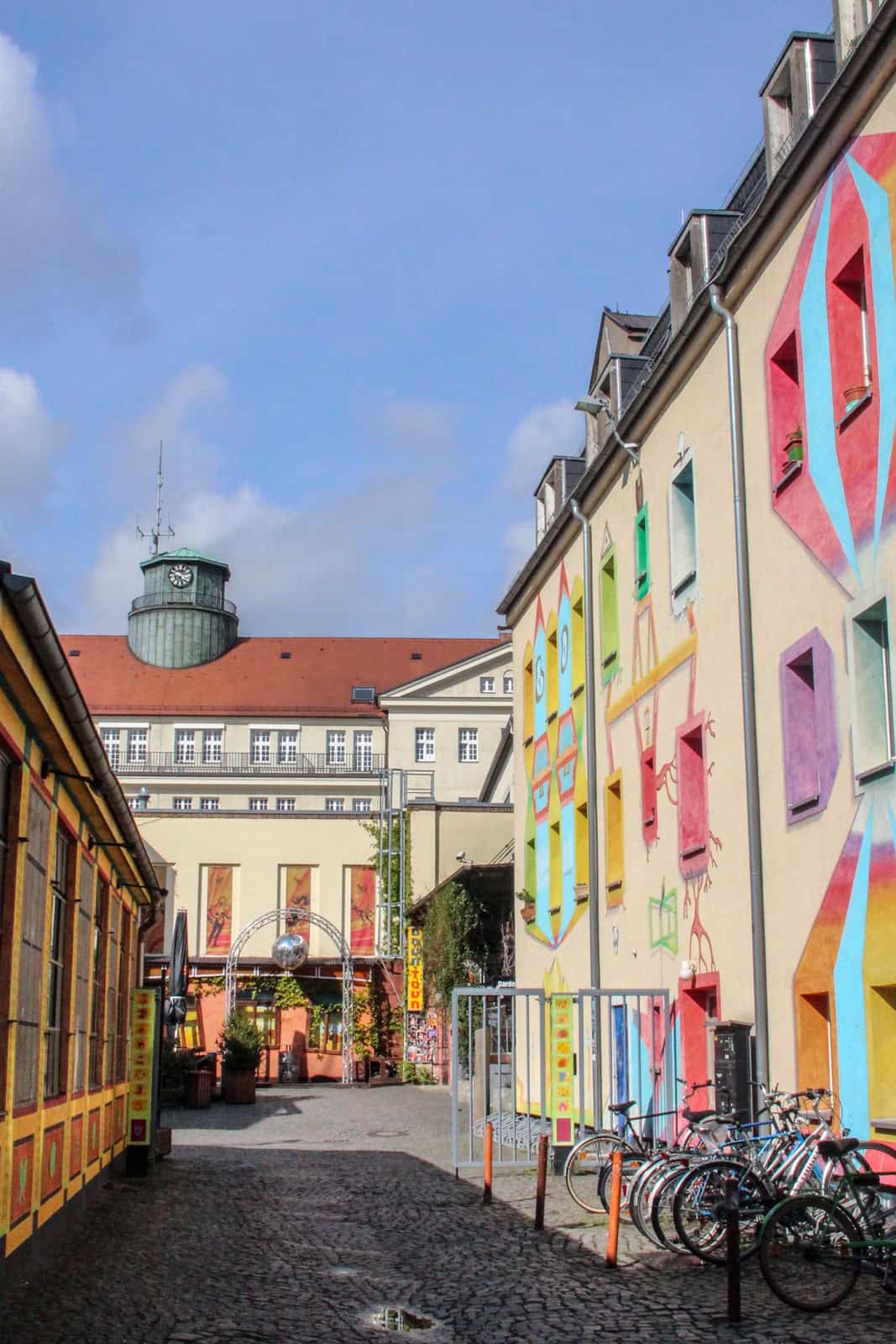
Art houses of Dresden.
Green Dresden – More than a Modern Metropolis
Dresden is a biker’s haven, and cycling this compact city is one of the best ways to explore what it offers outside of the Old and New Towns. The 860km Elbe Cycle Route opens up another side to Dresden that is easily explored – a vast open landscape free of development yet rich in the old culture.
Seen as one of the best cycle routes in Europe, I spent a few hours casually cycling this route past castles and palaces, parks and gardens, hillside vineyards, and luxury hotels. The accessible route is easy to follow and takes you to so many viewpoints that you might well spend more time off your bike admiring your surroundings than on it.
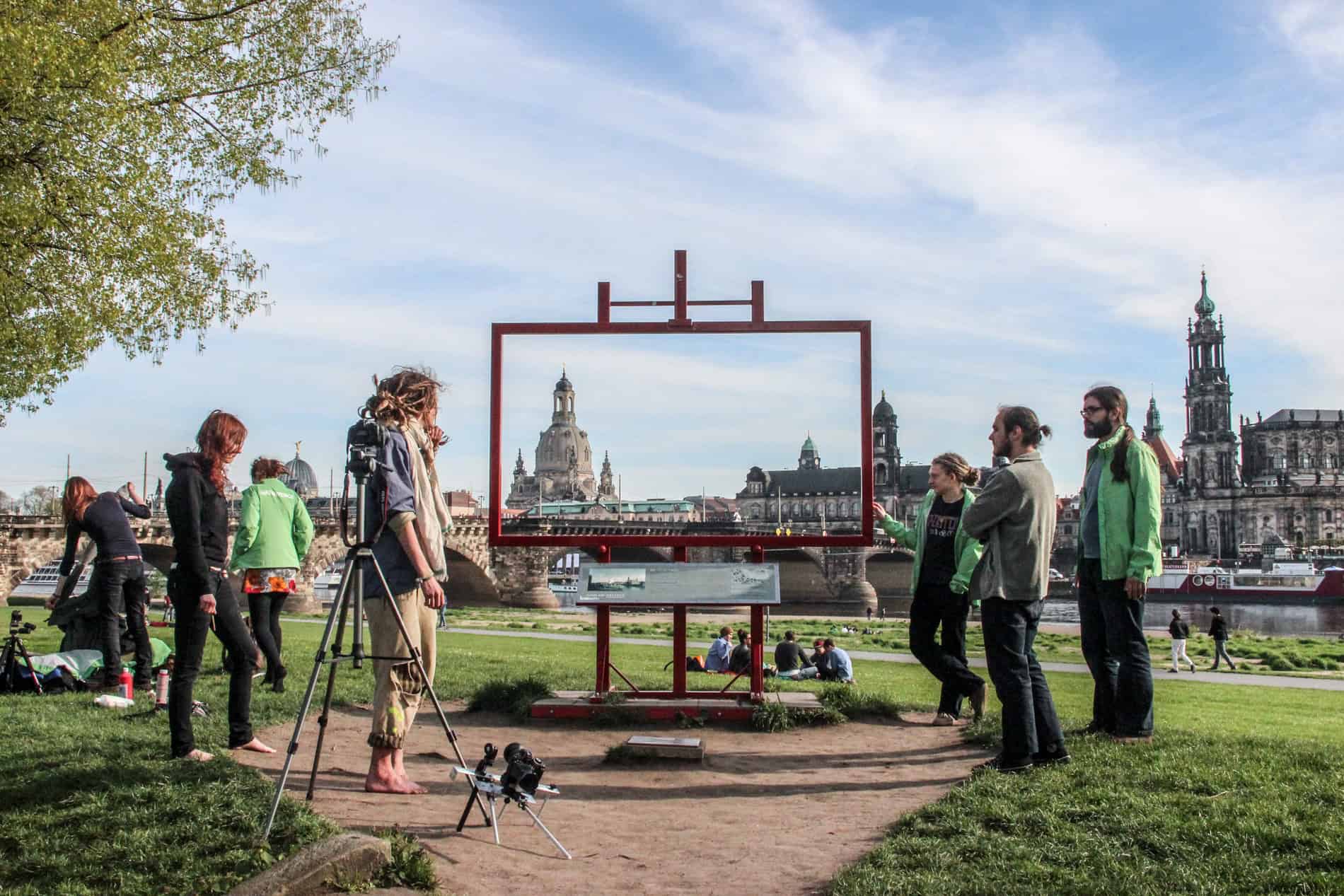
From new to old – the picture frame to Dresden Altstadt.
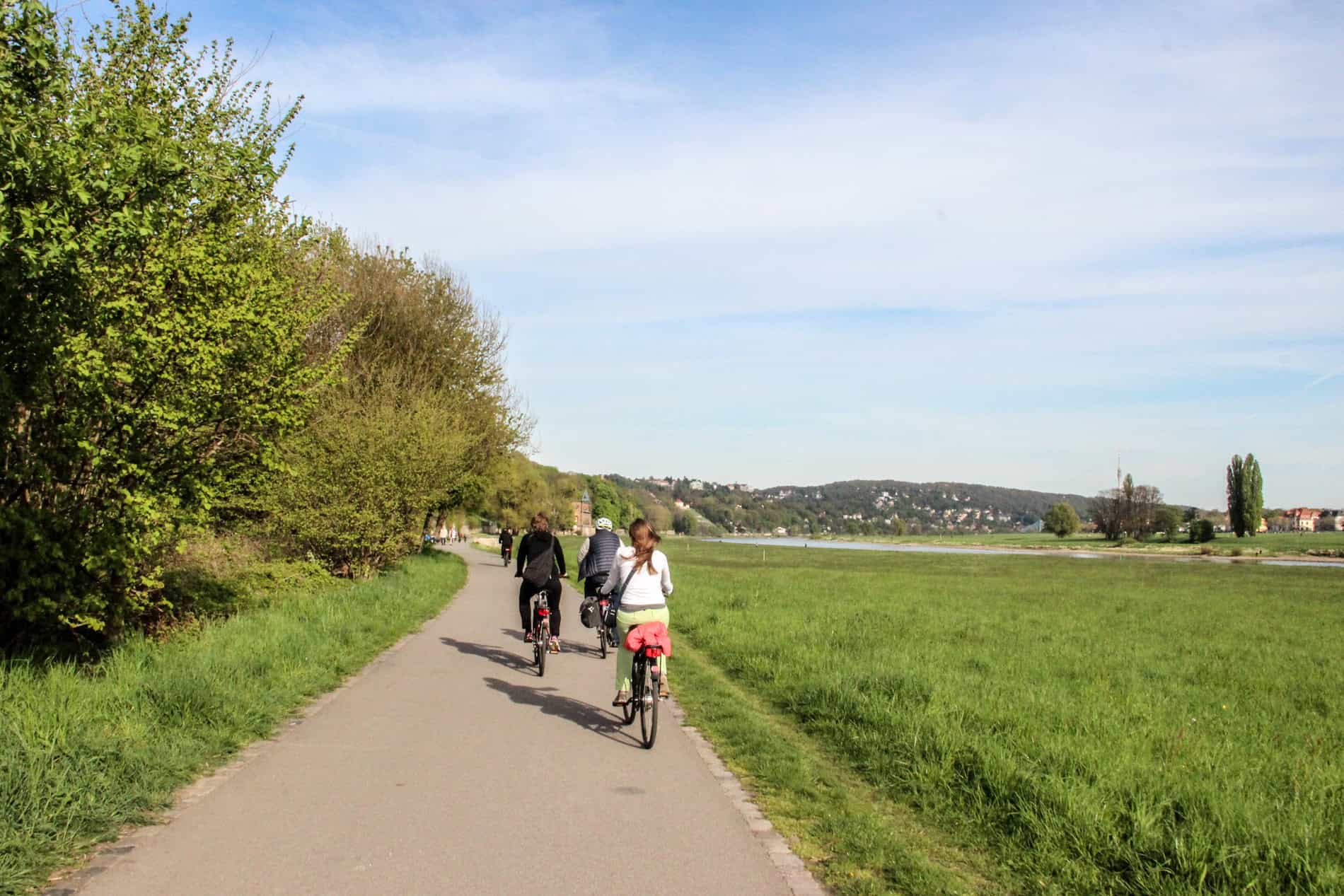
On the Elbe Cycle Path from Dresden.
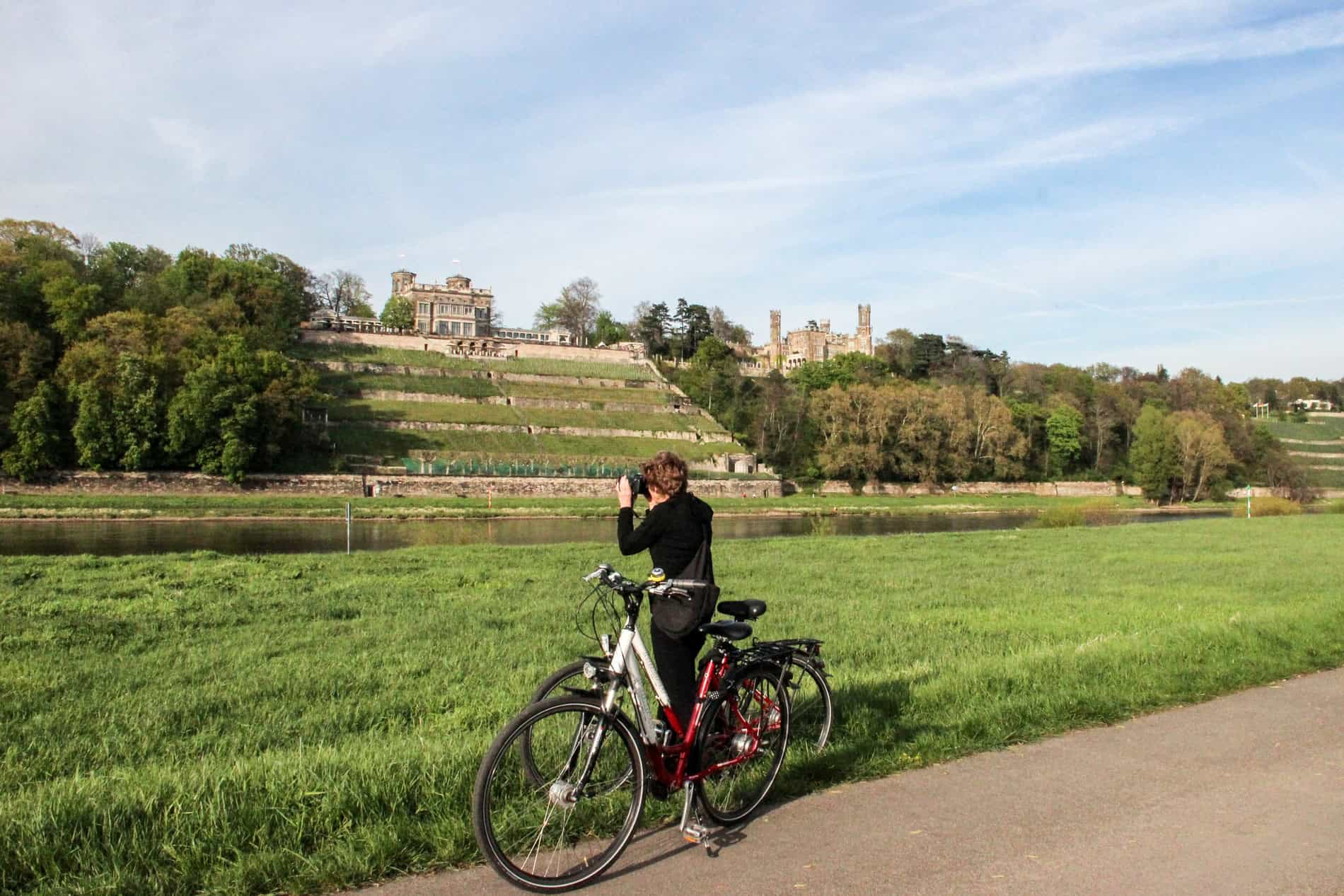
Passing Lingnerschloss Castle.
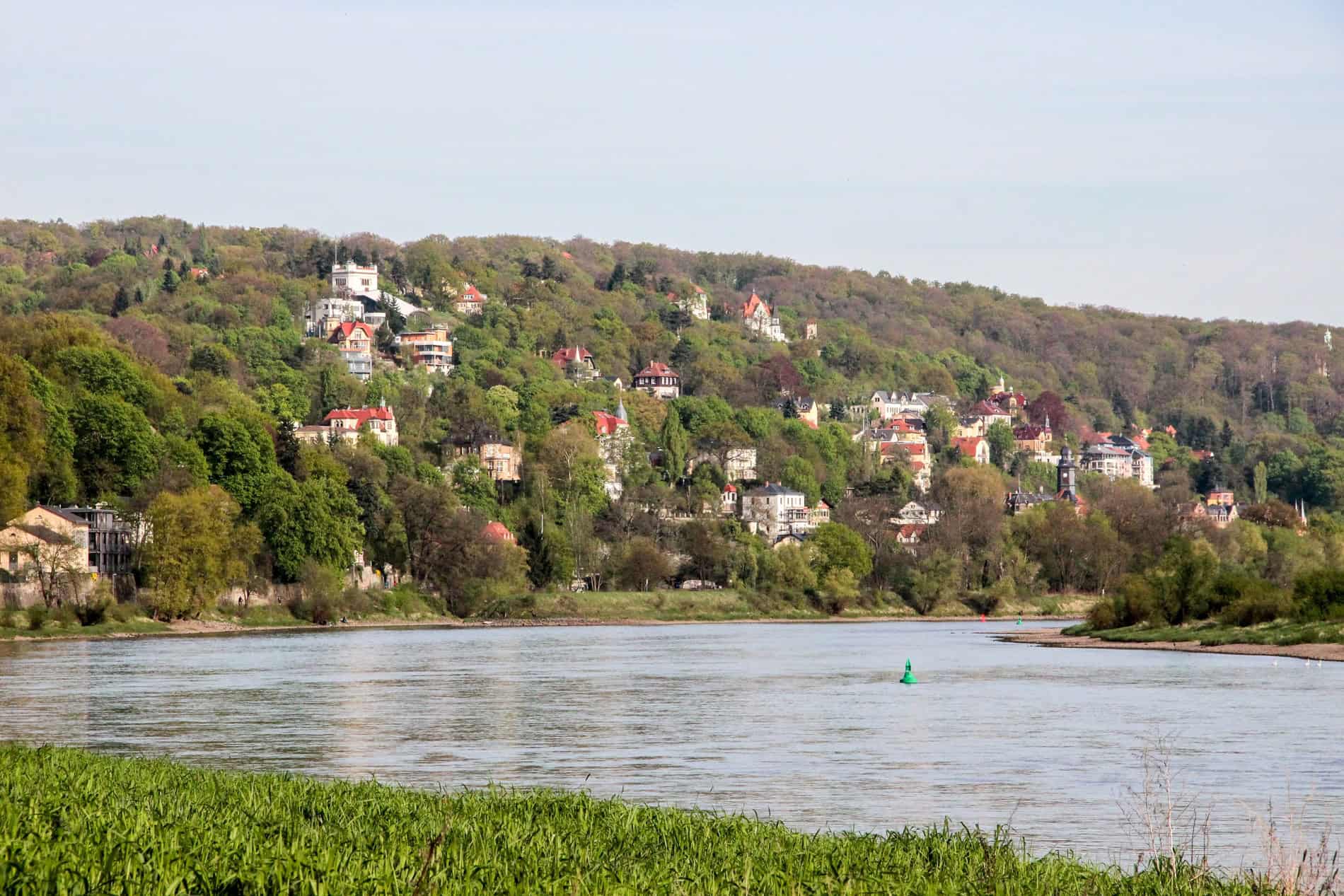
Houses on the hill on the Elbe River.
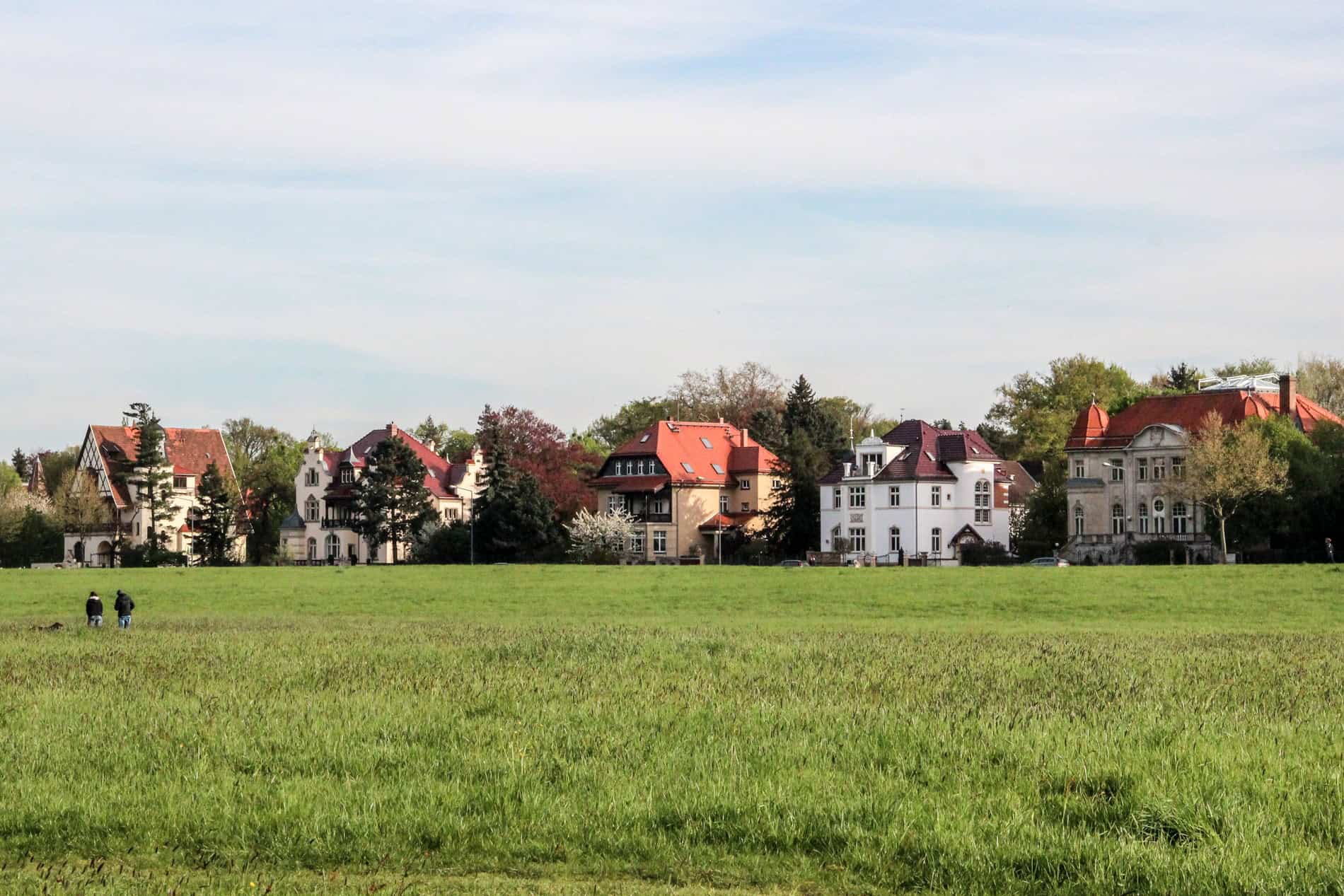
Rural pockets outside Dresden city.
Is Dresden Worth Visiting?
Dresden is much cooler than you think, especially when you venture outside of the Old Town area that gives Dresden its classic reputation. It’s a city always in flux that hasn’t stopped evolving after its days of wartime destruction and socialist occupation. Still mending, repairing, and catching up, there will always be more to Dresden beyond your first visit.
Dresden City Tours
There are many ways to get around Dresden’s attractions and learn about the city’s history.
Walk: Take a 2-hour walking tour with a local guide, and hear the stories that have shaped the city.
Bike: Take a 3-hour bike tour around the Altstadt, the Elbe Valley, and the new town’s hip neighbourhoods.
Boat: Cruise down the Elbe River and see a conveyor belt of Dresden’s historic landmarks from the water (with commentary).
Bus: The Hop-On Hop-Off Sightseeing Bus allows you to see the sites at your own pace (the ticket includes entrance to some landmarks).
Things to Know to Visit Dresden
Getting there and getting around
- The 108 km railway line from Dresden to Leipzig was the first long-distance rail link in Germany, opened 175 years ago in 1839. Deutsche Bahn (DB) allows you to book tickets for routes throughout Germany and connections to Europe.
- Details on bike hire and tours in Dresden can be found on the Next Bike website and mobile app. Alternatively, many guesthouses and hotels offer bike hire.
- Culture vultures and those planning on using many transport links might be better off taking advantage of the Dresden City Card. Prices start from €17 for a single-day card and €24 for two days. The card gives unlimited access to the city bus, tram, and train, free admission to museums, and concessions for 120 other tourist attractions.
Travelling in Former East Germany
Like Leipzig, Dresden also played an important role in the Peaceful Revolutions across GDR cities in 1989, leading to the fall of the Berlin Wall. To visit areas significant to this time, check out the Dresden Revolution Trail. The Stassi Museum (former state headquarters) is also in the center of the city. The Bautzner Strasse memorial is adjacent to the former prison.
You can also consider combining your trip to Dresden with other former cities of East Germany, including Erfurt, Potsdam and Weimar.
My trip to Dresden was supported by Dresden Marketing, a perfect fit for my Fall of the Wall series of articles and completing my journey through the towns and cities of former (GDR) East Germany perfectly. As always, all opinions remain my own.


John StVincent says
The price of the Dresden City Card: 9.9 euros for ONE day and 29.9 euros for TWO days, is that correct?
Becki says
Yes, it’s more because it has more perks, such as additional free admission to 13 museums.
Lynn Chen says
I like your blog so much. One of my friend who met you in Korea recommended your blog to me. I enjoyed a lot reading it. I will visit Europe in one week and go to Dresden to meet one friend. Thank you for sharing your trip before I go. It gave me inspiration to my trip:)
Jen Seligmann says
I’ve always wanted to visit Dresden. I’ve read so many cool things about the city from its brilliant architecture to cool bars and nightlife. I love that it is becoming one of the greenest cities in the world too. Great wrap up Becki.
Dale says
With all of those magnificent historic buildings (including the rebuilds) and all of that amazing street art, we’d be fools not to want to go should we make it back to Germany again in the future.
It certainly looks more interesting that Frankfurt which turned out to be a bit of a bore.
Stef says
I just visited Dresden in March, it’s a really nice city! your photos reminded me a lot of my weekend there 🙂
Naomi says
It’s so nice to see a blog about Dresden! My grandpa was from there and I love the city – although the stories my mam tell me when it was East Germany, the transformation of the city is incredible. I’ve only been briefly twice but I would love to go again to discover the city properly.
Becki says
I bet your mum has some very interesting stories to tell! You have a perfect excuse to go back!